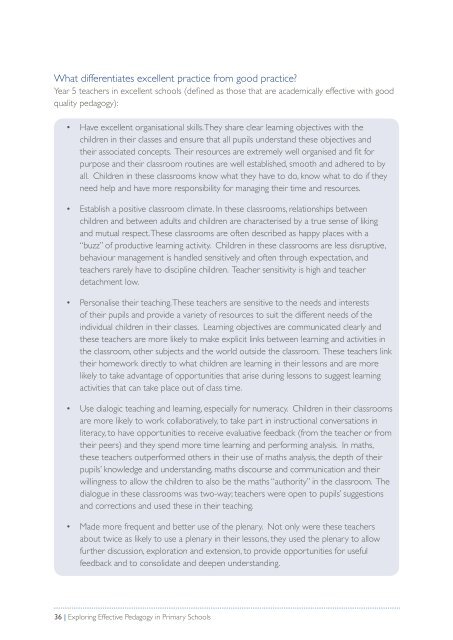Pearson-Exploring-Effective-Pedagogy-in-Primary-Schools
Pearson-Exploring-Effective-Pedagogy-in-Primary-Schools
Pearson-Exploring-Effective-Pedagogy-in-Primary-Schools
Create successful ePaper yourself
Turn your PDF publications into a flip-book with our unique Google optimized e-Paper software.
What differentiates excellent practice from good practice?Year 5 teachers <strong>in</strong> excellent schools (def<strong>in</strong>ed as those that are academically effective with goodquality pedagogy):• Have excellent organisational skills. They share clear learn<strong>in</strong>g objectives with thechildren <strong>in</strong> their classes and ensure that all pupils understand these objectives andtheir associated concepts. Their resources are extremely well organised and fit forpurpose and their classroom rout<strong>in</strong>es are well established, smooth and adhered to byall. Children <strong>in</strong> these classrooms know what they have to do, know what to do if theyneed help and have more responsibility for manag<strong>in</strong>g their time and resources.• Establish a positive classroom climate. In these classrooms, relationships betweenchildren and between adults and children are characterised by a true sense of lik<strong>in</strong>gand mutual respect. These classrooms are often described as happy places with a“buzz” of productive learn<strong>in</strong>g activity. Children <strong>in</strong> these classrooms are less disruptive,behaviour management is handled sensitively and often through expectation, andteachers rarely have to discipl<strong>in</strong>e children. Teacher sensitivity is high and teacherdetachment low.• Personalise their teach<strong>in</strong>g. These teachers are sensitive to the needs and <strong>in</strong>terestsof their pupils and provide a variety of resources to suit the different needs of the<strong>in</strong>dividual children <strong>in</strong> their classes. Learn<strong>in</strong>g objectives are communicated clearly andthese teachers are more likely to make explicit l<strong>in</strong>ks between learn<strong>in</strong>g and activities <strong>in</strong>the classroom, other subjects and the world outside the classroom. These teachers l<strong>in</strong>ktheir homework directly to what children are learn<strong>in</strong>g <strong>in</strong> their lessons and are morelikely to take advantage of opportunities that arise dur<strong>in</strong>g lessons to suggest learn<strong>in</strong>gactivities that can take place out of class time.• Use dialogic teach<strong>in</strong>g and learn<strong>in</strong>g, especially for numeracy. Children <strong>in</strong> their classroomsare more likely to work collaboratively, to take part <strong>in</strong> <strong>in</strong>structional conversations <strong>in</strong>literacy, to have opportunities to receive evaluative feedback (from the teacher or fromtheir peers) and they spend more time learn<strong>in</strong>g and perform<strong>in</strong>g analysis. In maths,these teachers outperformed others <strong>in</strong> their use of maths analysis, the depth of theirpupils’ knowledge and understand<strong>in</strong>g, maths discourse and communication and theirwill<strong>in</strong>gness to allow the children to also be the maths “authority” <strong>in</strong> the classroom. Thedialogue <strong>in</strong> these classrooms was two-way; teachers were open to pupils’ suggestionsand corrections and used these <strong>in</strong> their teach<strong>in</strong>g.• Made more frequent and better use of the plenary. Not only were these teachersabout twice as likely to use a plenary <strong>in</strong> their lessons, they used the plenary to allowfurther discussion, exploration and extension, to provide opportunities for usefulfeedback and to consolidate and deepen understand<strong>in</strong>g.36 | <strong>Explor<strong>in</strong>g</strong> <strong>Effective</strong> <strong>Pedagogy</strong> <strong>in</strong> <strong>Primary</strong> <strong>Schools</strong>


